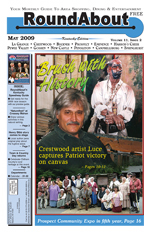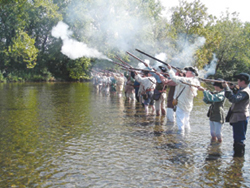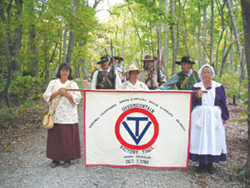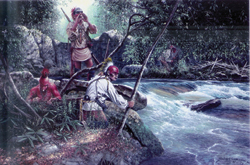



Brush with History
Crestwood
artist Luce
captures Patriot march on canvas
He
traveled where Revolutionary War
soldiers fought and died in key battle
By
Helen E. McKinney
Contributing Writer
 |
|
May
2009 Kentucky |
(May 2009) – To achieve a better understanding
of history and the sacrifices made by men and women during the formulative
years of the United States, artist Richard Luce has literally walked
in the footsteps of these individuals. His dedication is part of an
undertaking to create a series of paintings based on the 1780 Battle
of King’s Mountain and the events leading up to it.
“To read a book is one thing,” said Luce, but to actually
take part in a recreation of a historical moment is the impetus he sought
for inspiration. “Walking over the same ground, spending as much
time as they did,” made the trek worthwhile for the Crestwood,
Ky., resident.
With every step they took, these militia men were going farther and
farther from home, Luce said. Accomplishing the same feat made him realize
the dedication of the Overmountain, or Backwater, Men.
Of Scotch-Irish descent, these men had settled West, or “over”
the Appalachian Mountains in what is now Western Virginia and Eastern
Tennessee. Thus they earned the name, Overmountain Men. Their two-week
campaign across the Appalachian Mountains in 1780 in pursuit of British
Maj. Patrick Ferguson ended at the Battle of King’s Mountain.
 |
|
Photo provided by Richard Luce Re-enactor
and |
At 3 p.m. Saturday, Oct. 7, 1780, these men, roughly numbering
900 Patriots (including John Crockett, father of Davy Crockett) faced
1,000 Tories on King’s Mountain, S.C. King’s Mountain was
a rocky forested hill in the upper Piedmont near the border between
North Carolina and South Carolina. The men had traveled from Virginia
for a 70-minute battle that most historians label one of the most influential
in American history.
Theodore Roosevelt described the event in his book, “The Winning
of the West,” by writing “This brilliant victory marked the
turning point of the American Revolution.” Maj. Ferguson, the only
British person on the battlefield, died that day. Gen. Charles Cornwallis,
commander of all the British forces in the south, lost one-third of
his army and retreated to South Carolina.
Since 1975, the Overmountain Victory Trail Association has conducted
a re-enactment of the Overmountain Men’s march to King’s Mountain.
Luce joined the march last year, which began Sept. 20 in Abingdon, Va.,
and ended Oct. 7 at King’s Mountain National Military Park, S.C.
Originally from Yonkers, N.Y., Luce, 59, admits he did not know much
about the battle before the trek. In August 2008, he visited Crockett’s
birthplace in Tennessee with good friend, Steve Ricker. There, they
met members of the Overmountain Victory Trail Association who told them
about the march that would take place the following month.
Luce was invited along by OVTA member Mike Dahl, who had previously
seen his artwork. Dahl, who lives in Knoxville, Tenn., said he instinctively
knew that Luce “was the man to tell the story of the Overmountain
Men with a paint brush.”
For Luce, half the fun was learning the history behind the battle and
related events. The group camped at every campsite where the Overmountain
Men were encamped.
“We walked 30 miles of the original trail beds,” said Luce,
who snapped photographs and took notes along the way. The national historic
trail is 330 miles in length, but only 70 miles are open for public
use, said Paul Carson, superintendent of the Overmountain Victory National
Historic Trail.
Only the Patriot route of the 1780 Kings Mountain campaign is identified
and marked. The trail goes through Virginia, Tennessee, North Carolina
and South Carolina and the trail was created through congressional authorization.
The National Park Service oversees the trail.
 |
|
Photos
provided by Richard Luce Re-enactors
taking part in battle |
The trail provides a physical connection to the past,
said Carson. “The trail provides a real resource on the ground
that people can visit and learn about the story. It’s one thing
to read about it, another to stand there.”
From a military standpoint, many historians consider this battle a major
turning point in the Revolutionary War, which lasted from 1775 to 1783,
said Carson. The war took place in different phases, he said, beginning
in New England and then moving to the middle states. After a series
of failures, the British moved their strategy to the South.
By the end of 1780 they thought they would capture South Carolina, said
Carson. But the British plan to reconquer the colonies failed. As a
result, “it was an utter defeat for Ferguson,” Carson said.
The British retreated to South Carolina and did not do much for the
next three to four months. This interlude allowed the Patriots to create
a regular army (as opposed to a militia) in North Carolina. This army
successfully resisted the British, and Gen. Cornwallis surrendered at
Yorktown, with the Patriots winning the War for Independence.
The Battle of King’s Mountain changed what the war looked like
up until this point, said Carson. “It stopped their (British) momentum.”
Many people are under the perception that the Revolutionary War took
place up North, Carson said. They are not aware that actual fighting
took place in the southern colonies as well.
 |
“It’s exciting to have an artist focusing on
the campaign,” he said. Carson pointed out that most artists have
focused on the battle itself, with some exceptions. “Luce will
present a fresh perspective on the campaign and the events that happened
on it.”
To give his work realistic detail, Luce said that making the march at
the same time of year, even having rain when the Overmountain Men experienced
rain, gave him “a better appreciation for what people did back
then.”
Along the way the re-enactors stopped at different schools explaining
their mission. Luce said 6,700 students received a hands-on look at
history, and “the kids were fascinated.”
Dahl said, “Richard looked at the trail, its history, those places
along the trail where the ground speaks to you in a way that we never
had. He gave us a new insight into the trail we have never seen before.”
Randell Jones, historian, writer and past president of the association,
said of the battle, “It’s a heroic tale and everybody loves
a hero. The story intrigued me for the heroics exhibited by these mountain
men and also because my ancestors lived in East Tennessee.”
 |
Jones, who lives in Winston-Salem, N.C., has participated
in some portion of the march since 1999. “People who follow the
route of the Overmountain Men see the landscape and can more readily
imagine the challenge faced by a party of 1,000 militiamen moving across
the mountains and then down through North Carolina.”
He said the battle was significant for several reasons. “It was
American fighting American. It was Loyalist vs. Patriot, a true civil
war.”
The battle was the only battle in the American Revolution in which the
rifle played a deciding role. The entire force of Overmountain Men were
mounted and there was not a single Continental soldier or Continental
officer involved.
Jones said the association does a great job telling this story. The
experience of the march is different every year because “special
things happen that are never repeated.” It is this uniqueness that
Luce aspires to capture on canvas for others to experience visually.
Luce said history has been his lifelong passion. He remembers being
engrossed in a book about World War II by age 10. So when he took up
painting, he jumped into historical subject matter naturally.
“History is more than just names and dates,” said Dahl. “History
is the story of people and the times they lived in.”
• To view “The Backwater Men,” the first painting in Luce’s series, visit: www.RichardLuce.com. For more information about the Battle of King’s Mountain visit: www.ovta.org or www.nps.gov.